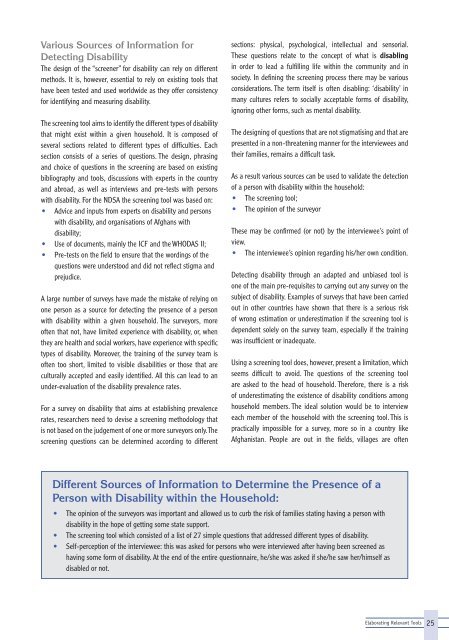Conducting Surveys on Disability: A Comprehensive Toolkit
Conducting Surveys on Disability: A Comprehensive Toolkit
Conducting Surveys on Disability: A Comprehensive Toolkit
You also want an ePaper? Increase the reach of your titles
YUMPU automatically turns print PDFs into web optimized ePapers that Google loves.
Various Sources of Informati<strong>on</strong> for<br />
Detecting <strong>Disability</strong><br />
The design of the “screener” for disability can rely <strong>on</strong> different<br />
methods. It is, however, essential to rely <strong>on</strong> existing tools that<br />
have been tested and used worldwide as they offer c<strong>on</strong>sistency<br />
for identifying and measuring disability.<br />
The screening tool aims to identify the different types of disability<br />
that might exist within a given household. It is composed of<br />
several secti<strong>on</strong>s related to different types of difficulties. Each<br />
secti<strong>on</strong> c<strong>on</strong>sists of a series of questi<strong>on</strong>s. The design, phrasing<br />
and choice of questi<strong>on</strong>s in the screening are based <strong>on</strong> existing<br />
bibliography and tools, discussi<strong>on</strong>s with experts in the country<br />
and abroad, as well as interviews and pre-tests with pers<strong>on</strong>s<br />
with disability. For the NDSA the screening tool was based <strong>on</strong>:<br />
• Advice and inputs from experts <strong>on</strong> disability and pers<strong>on</strong>s<br />
with disability, and organisati<strong>on</strong>s of Afghans with<br />
disability;<br />
• Use of documents, mainly the ICF and the WHODAS II;<br />
• Pre-tests <strong>on</strong> the field to ensure that the wordings of the<br />
questi<strong>on</strong>s were understood and did not reflect stigma and<br />
prejudice.<br />
A large number of surveys have made the mistake of relying <strong>on</strong><br />
<strong>on</strong>e pers<strong>on</strong> as a source for detecting the presence of a pers<strong>on</strong><br />
with disability within a given household. The surveyors, more<br />
often that not, have limited experience with disability, or, when<br />
they are health and social workers, have experience with specific<br />
types of disability. Moreover, the training of the survey team is<br />
often too short, limited to visible disabilities or those that are<br />
culturally accepted and easily identified. All this can lead to an<br />
under-evaluati<strong>on</strong> of the disability prevalence rates.<br />
For a survey <strong>on</strong> disability that aims at establishing prevalence<br />
rates, researchers need to devise a screening methodology that<br />
is not based <strong>on</strong> the judgement of <strong>on</strong>e or more surveyors <strong>on</strong>ly. The<br />
screening questi<strong>on</strong>s can be determined according to different<br />
secti<strong>on</strong>s: physical, psychological, intellectual and sensorial.<br />
These questi<strong>on</strong>s relate to the c<strong>on</strong>cept of what is disabling<br />
in order to lead a fulfilling life within the community and in<br />
society. In defining the screening process there may be various<br />
c<strong>on</strong>siderati<strong>on</strong>s. The term itself is often disabling: ‘disability’ in<br />
many cultures refers to socially acceptable forms of disability,<br />
ignoring other forms, such as mental disability.<br />
The designing of questi<strong>on</strong>s that are not stigmatising and that are<br />
presented in a n<strong>on</strong>-threatening manner for the interviewees and<br />
their families, remains a difficult task.<br />
As a result various sources can be used to validate the detecti<strong>on</strong><br />
of a pers<strong>on</strong> with disability within the household:<br />
• The screening tool;<br />
• The opini<strong>on</strong> of the surveyor<br />
These may be c<strong>on</strong>firmed (or not) by the interviewee’s point of<br />
view.<br />
• The interviewee’s opini<strong>on</strong> regarding his/her own c<strong>on</strong>diti<strong>on</strong>.<br />
Detecting disability through an adapted and unbiased tool is<br />
<strong>on</strong>e of the main pre-requisites to carrying out any survey <strong>on</strong> the<br />
subject of disability. Examples of surveys that have been carried<br />
out in other countries have shown that there is a serious risk<br />
of wr<strong>on</strong>g estimati<strong>on</strong> or underestimati<strong>on</strong> if the screening tool is<br />
dependent solely <strong>on</strong> the survey team, especially if the training<br />
was insufficient or inadequate.<br />
Using a screening tool does, however, present a limitati<strong>on</strong>, which<br />
seems difficult to avoid. The questi<strong>on</strong>s of the screening tool<br />
are asked to the head of household. Therefore, there is a risk<br />
of underestimating the existence of disability c<strong>on</strong>diti<strong>on</strong>s am<strong>on</strong>g<br />
household members. The ideal soluti<strong>on</strong> would be to interview<br />
each member of the household with the screening tool. This is<br />
practically impossible for a survey, more so in a country like<br />
Afghanistan. People are out in the fields, villages are often<br />
Different Sources of Informati<strong>on</strong> to Determine the Presence of a<br />
Pers<strong>on</strong> with <strong>Disability</strong> within the Household:<br />
• The opini<strong>on</strong> of the surveyors was important and allowed us to curb the risk of families stating having a pers<strong>on</strong> with<br />
disability in the hope of getting some state support.<br />
• The screening tool which c<strong>on</strong>sisted of a list of 27 simple questi<strong>on</strong>s that addressed different types of disability.<br />
• Self-percepti<strong>on</strong> of the interviewee: this was asked for pers<strong>on</strong>s who were interviewed after having been screened as<br />
having some form of disability. At the end of the entire questi<strong>on</strong>naire, he/she was asked if she/he saw her/himself as<br />
disabled or not.<br />
Elaborating Relevant Tools<br />
25

















